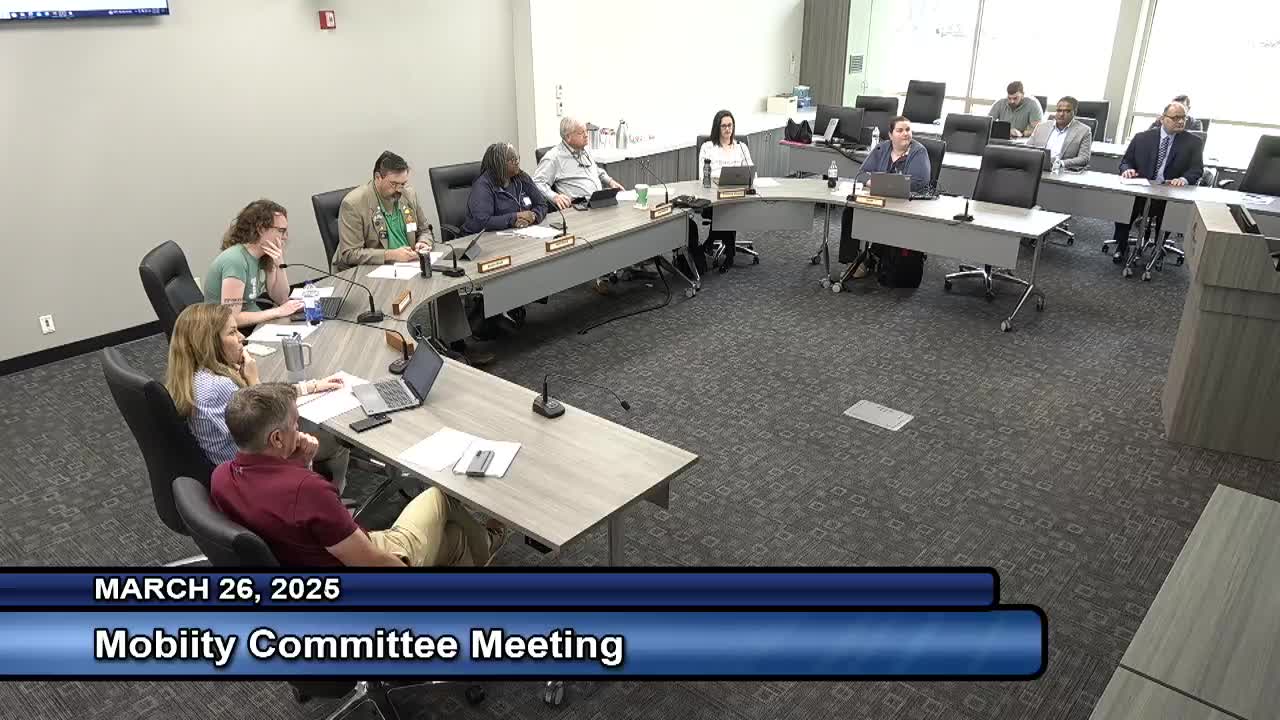Mobility committee backs TRIP application to fund Colorado Boulevard, Frye District, Katy Trail and downtown quiet‑zone work
March 26, 2025 | Denton City, Denton County, Texas
This article was created by AI summarizing key points discussed. AI makes mistakes, so for full details and context, please refer to the video of the full meeting. Please report any errors so we can fix them. Report an error »

City transportation staff asked the Mobility Committee to approve a package of projects to include in the city’s FY2025 TRIP funding application to DCTA, highlighting sidewalks, bike accommodations and several railroad quiet‑zone crossings downtown.
Greg Scott, Transportation Services, said staff had “identified 3 projects for 2025 funding” and described a set of sidewalk and bicycle improvements on Colorado Boulevard between Loop 288 and the A‑train line that would fill south‑side sidewalk gaps and bring sidewalks up to ADA standards. He said the proposed package also included work in the Frye District and a multimodal extension along the Katy Trail.
Seth Garcia, interim director of Capital Projects, called out a cost increase for the Katy Trail extension tied to a large floodway that requires a pedestrian bridge and noted an earlier 2023 DCTA allocation for part of that work. He said the city will close a pedestrian crossing across the railroad and move the trail to the north side of the tracks to avoid at‑grade crossing conflicts. Garcia said a savings of about $480,000 from an All‑Way Crossing project could be reallocated toward construction of pedestrian improvements at three downtown UPRR crossings — Hickory, McKinney and Sycamore — to support the quiet‑zone work.
Committee members pressed staff on scope and priorities. One asked whether the quiet‑zone crossings were “fully funded” to the city’s opinion of probable construction cost; staff answered they were funded through design but the final construction bids would determine final costs. Another member emphasized that TRIP dollars are intended to facilitate transit access and urged staff to avoid using the TRIP allocation as a substitute for routine street repairs that should be paid for with maintenance and operations funds or bonds.
Staff and committee members discussed the use of tactical urbanism on Moore Street — a pilot approach that places temporary, inexpensive treatments in the right of way to test solutions before committing to permanent construction — and affirmed that public engagement will shape final design of bike lanes, curb extensions and other lane‑separation concepts. Greg Scott said the preliminary budget assumes some protected on‑street bike lanes but that final design would be subject to public input.
Next steps: with committee approval staff said the TRIP package would go to City Council and to the DCTA board for consideration; a council resolution is expected on or about April 27, 2025.
Why it matters: the package combines pedestrian, bicycle and rail‑safety investments intended to increase safe access to transit and to the Katy Trail, while tying several downtown crossings into a single quiet‑zone effort.
Greg Scott, Transportation Services, said staff had “identified 3 projects for 2025 funding” and described a set of sidewalk and bicycle improvements on Colorado Boulevard between Loop 288 and the A‑train line that would fill south‑side sidewalk gaps and bring sidewalks up to ADA standards. He said the proposed package also included work in the Frye District and a multimodal extension along the Katy Trail.
Seth Garcia, interim director of Capital Projects, called out a cost increase for the Katy Trail extension tied to a large floodway that requires a pedestrian bridge and noted an earlier 2023 DCTA allocation for part of that work. He said the city will close a pedestrian crossing across the railroad and move the trail to the north side of the tracks to avoid at‑grade crossing conflicts. Garcia said a savings of about $480,000 from an All‑Way Crossing project could be reallocated toward construction of pedestrian improvements at three downtown UPRR crossings — Hickory, McKinney and Sycamore — to support the quiet‑zone work.
Committee members pressed staff on scope and priorities. One asked whether the quiet‑zone crossings were “fully funded” to the city’s opinion of probable construction cost; staff answered they were funded through design but the final construction bids would determine final costs. Another member emphasized that TRIP dollars are intended to facilitate transit access and urged staff to avoid using the TRIP allocation as a substitute for routine street repairs that should be paid for with maintenance and operations funds or bonds.
Staff and committee members discussed the use of tactical urbanism on Moore Street — a pilot approach that places temporary, inexpensive treatments in the right of way to test solutions before committing to permanent construction — and affirmed that public engagement will shape final design of bike lanes, curb extensions and other lane‑separation concepts. Greg Scott said the preliminary budget assumes some protected on‑street bike lanes but that final design would be subject to public input.
Next steps: with committee approval staff said the TRIP package would go to City Council and to the DCTA board for consideration; a council resolution is expected on or about April 27, 2025.
Why it matters: the package combines pedestrian, bicycle and rail‑safety investments intended to increase safe access to transit and to the Katy Trail, while tying several downtown crossings into a single quiet‑zone effort.
View full meeting
This article is based on a recent meeting—watch the full video and explore the complete transcript for deeper insights into the discussion.
View full meeting
